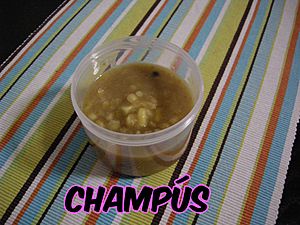Champús facts for kids
 |
|
| Type | Beverage |
|---|---|
| Country of origin | South America |
| Ingredients | Maize, fruits such as lulo (also known as naranjilla), pineapple, quince or guanábana, sweetened with panela and seasoned with cinnamon, cloves and orange tree leaves. |
Champús is a tasty, thick drink popular in countries like Peru, Ecuador, and southwest Colombia. It's made from maize (corn), different fruits, and is sweetened with panela. People also add spices like cinnamon and cloves, plus orange tree leaves for extra flavor.
In Peru, champús is usually served warm. Instead of lulo, they often use apple, guanábana, and quince. You can find it sold on the streets by a champusera. These sellers are a common sight in Lima, and they often pass their special recipes down through their families.
In Ecuador, champús is made with maize flour, panela, and green lemon tree leaves. It's a traditional drink for special events, especially during funeral rites in November or at adult funerals. This is because some indigenous traditions believe it's a favorite drink of those who have passed away.
In Colombia, they use crushed maize, panela, lulo, pineapple, cinnamon, cloves, and orange tree leaves. In southern regions like Nariño and Cauca, it's a popular drink for Christmas. In Nariño, they might also add leaves from cedrón and congona plants. But in Valle del Cauca, it's served very cold and enjoyed any time of the year.
Sometimes, in parts of Peru and southern Colombia, champús is made with mote. Mote is cooked maize, which makes the drink much thicker. When it's made this way, it's often eaten like a dessert instead of just a drink.
Contents
What is Champús?
Champús is a unique drink that mixes many flavors. It's known for being both filling and refreshing. People often say it can cure both thirst and hunger at the same time! It might look a bit different at first, but many find it delicious.
Where Did Champús Come From?
The exact start of the word "champús" is a bit of a mystery. There isn't much old information about it. However, we know this drink is enjoyed in many parts of South America, like Ecuador, Peru, and Colombia. This suggests it has a long history across these regions.
Ancient Traditions
In 1960, a person named Daniel Guevara wrote that champús was used by indigenous tribes in Ecuador for funeral rituals. Because it's a traditional indigenous drink, much like chicha and guarapo, many believe it shares a similar ancient origin.
Different Ideas About the Name
Some people think the name "champús" comes from the Spanish language. The "Diccionario of Vallecaucanismos" by Leonardo Tascón suggests that "champús" in Spanish can mean "something done wrong" or "a mixture of everything." He thought the Spanish might have given it this name because it mixes many different ingredients.
Others believe the word might come from an African language. However, it's hard to prove this idea because no one has found a specific African word that sounds like "champús" and relates to the drink.
A more popular idea is that the word comes from the Quechuan languages. The word "chapuy" in Quechua means "to make dough." Since maize dough is a main part of champús, this theory makes a lot of sense.
Champús and Families
In Colombia, champús is often seen as a drink that comes from families with lower incomes. It's a drink that brings together the energy of corn, the sweetness of sugar cane, and the strong flavors of cloves and cinnamon. The orange leaves add a special secret touch.
Even though it's now enjoyed all year, it was traditionally made for Christmas celebrations. Many people also consider it a dessert because it's so filling.
There's a famous place in Cali called "El Champús de Lola" that has been selling this drink for almost 30 years. The original recipe has been passed down through generations. Even with many places selling champús, customers often say the best ones come from the street vendors in lower-income areas. These vendors sometimes sell it to help raise money for their families.
Champús is a drink that goes well with lunch or savory snacks. It's also a drink that helps bring families together.
How to Make Champús
Making champús involves a few steps. First, you need to cook the corn for about an hour until it's soft. Then, take out one cup of the cooked corn, grind it up, and put it back into the mixture.
Next, you prepare a sweet caramel. You do this by cooking panela with orange leaves, cloves, and cinnamon. Once the caramel is ready, you add it to the corn mixture. Finally, you stir in the pulp of lulo and diced pineapple. After mixing everything well, you can serve it with ice.
Images for kids
See also
 In Spanish: Champús para niños
In Spanish: Champús para niños


